Advantages and disadvantages of growing potatoes using Dutch technology
Dutch farmers, despite the small amount of land available for growing crops, have managed to achieve high potato yields even on small plots. From 1 hectare, they manage to collect up to 50 tons of selected crops. What is the secret of planting potatoes in Holland and whether this technology is applicable to the conditions of Russia, we will tell further.
The content of the article
- Features of the Dutch method of growing potatoes
- Advantages and disadvantages
- Necessary materials
- Conditions for growing potatoes using Dutch technology
- Landing technology
- Further care
- Difficulties in the process of growing potatoes using Dutch technology
- Harvest time
- Tips and tricks from experienced gardeners
- Conclusion
Features of the Dutch method of growing potatoes
The Dutch method is to abandon holes and beds and is reduced to planting in furrows. The second feature is a special approach to the preparation of seed. Subject to the full range of agrotechnical measures, you can get about 35 tons of potatoes, and in good weather conditions - up to 50 tons.

Description and essence of the method
The essence boils down to the exact implementation of all agrotechnical methods in terms of time and quality. Emphasis is placed on increased soil aeration and planting of potatoes in ridges with a wide distance between the rows.
To increase yields, start with the germination of tubers. It allows you to shorten the cultivation time of the crop by up to two weeks and reduce the risks of not sprouting.
The soil is prepared in a special way - For Dutch planting, optimum looseness is required. Preparation of the soil begins in the fall and continues in the spring after the snow melts. Autumn processing includes digging the site, removing weeds and applying mineral fertilizers, especially nitrogen-containing ones. In the spring, the soil is loosened with a cultivator to a depth of 10-15 cm and phosphate and potassium fertilizers are applied - superphosphate and potassium sulfate.
The main essence of the technique is landing according to a specific algorithm and pattern. A distance of 70-85 cm is observed between rows, and 30 cm between bushes. It is convenient to use potato planters. The holes are dug manually with a pitchfork or a shovel to a depth of 6-9 cm. The prepared and germinated seed material is placed upside down and covered with soil.
What is the specificity
When growing potatoes according to the Dutch method, it is important:
- use varietal potatoes;
- follow the rules of crop rotation;
- timely fertilize;
- treat against pests, bacteria and viruses;
- carefully prepare the seed;
- competently process the soil;
- use milling tools;
- follow the landing pattern.
Are all varieties suitable for this method
For planting potatoes using this technique, only varietal potatoes purchased in nurseries are used.
Dutch varieties are best suited:
- Cleopatra is an early variety for sandy and clayey soil;
- Frisia is a mid-season potato with high resistance to viral diseases;
- Eba is a medium late yellow tuber variety with high immunity;
- Mona Lisa is a high-yielding medium early variety with the highest disease resistance, suitable for regions with a poor epidemic situation for potato diseases;
- Asterix is a mid-season variety with high keeping quality;
- Prior is an early variety with high resistance to nematodes and late blight.
Advantages and disadvantages
Of the positive aspects of agricultural technology, there are:
- high productivity;
- good consumer and commercial qualities;
- long-term preservation;
- low risk of lack of seedlings;
- active formation of tubers in each plant;
- impossibility of waterlogging.
However, the method also has disadvantages:
- high time and energy costs for the preparation of soil and seed;
- using only varietal potatoes;
- the complexity of crop rotation in small areas;
- the need to accurately follow the scheme and all recommendations;
- difficulties associated with the timing of agricultural receptions.
Necessary materials
For accurate adherence to the entire technique, certain materials and tools are required:
- varietal potatoes;
- mineral fertilizers - nitrogen, phosphate, potash;
- cultivator;
- potato planter;
- pitchfork;
- shovel.
For farms:
- trailed planters;
- milling plants for weed control;
- elevator diggers for harvesting.
Seed material of the second reproduction with high varietal purity is acquired.
Conditions for growing potatoes using Dutch technology
The technique is very accurate and requires a certain looseness of the soil and compliance with the rules of crop rotation.
An important condition is certified seed potatoes. Suitable for planting are standardized tubers with a diameter of 30-50 mm and a weight within 50 g. Each should have at least 5 eyes. Before planting, secondary sorting is carried out and only that material is selected for which the length of the shoots does not exceed 5 mm for the mechanical planting method and 2 cm for the manual planting.
Tubers are planted in soil warmed up to + 8 ... + 10 ° C. Moisture is checked as follows: the soil is taken in the palm, squeezed and thrown down. If the lump falls apart, the soil is ready.
Potatoes are grown in places where legumes (beans, peas) and cereals (oats or rye) used to grow. Oats in the fall can be used as green manure. A culture is not planted on one site more often than once every 3 years.
Landing technology
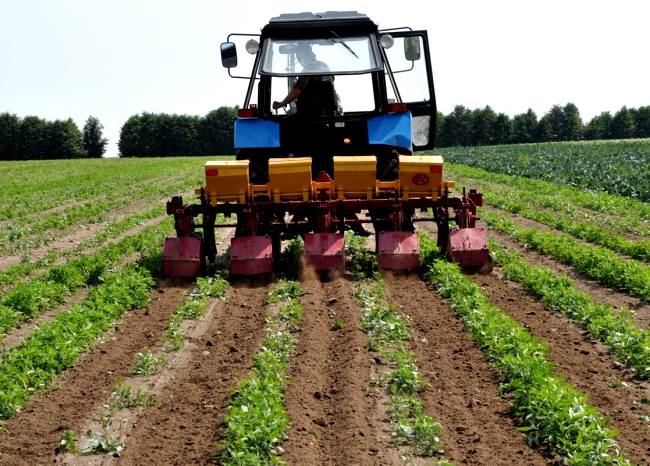
Compliance with the technology and all agrotechnical techniques is a key feature of the method. The slightest deviation threatens with a decrease in yield, obtaining weak plants and a small number of tubers. We will tell you in detail how potatoes are planted in Holland.
Site preparation on site
For planting, choose a flat area without the slightest slope. The place must be sunny, on a small hill, but by no means in lowlands where water accumulates. Also, the site should be protected from constant winds in order to avoid blowing out and overdrying the ridges.
The soil should be light and loose, heavy soils are facilitated by the introduction of river sand, too light ones are made heavier with peat.
Preparing tubers for planting
For planting, select whole tubers without signs of damage or disease, with a diameter of 3 to 5 cm and a mass of 50-60 g. Each tuber must have at least 5 eyes.
Germination begins 30 days before planting. Tubers are poured into one layer in a dark place at a temperature of + 16 ... + 18 ° C. The best bedding is paper or cotton. The number of storeys is not allowed in order to avoid waterlogging of the upper tubers from evaporation from the lower tiers.
For mechanical planting, the shoots should be 5 to 8 mm long; for the manual method, a length of 1-2 cm is allowed. Sorting of tubers according to the length of the shoots is carried out on the eve of planting. Too long shoots will break off with the mechanical method, therefore they are only suitable for the manual method.
Soil preparation
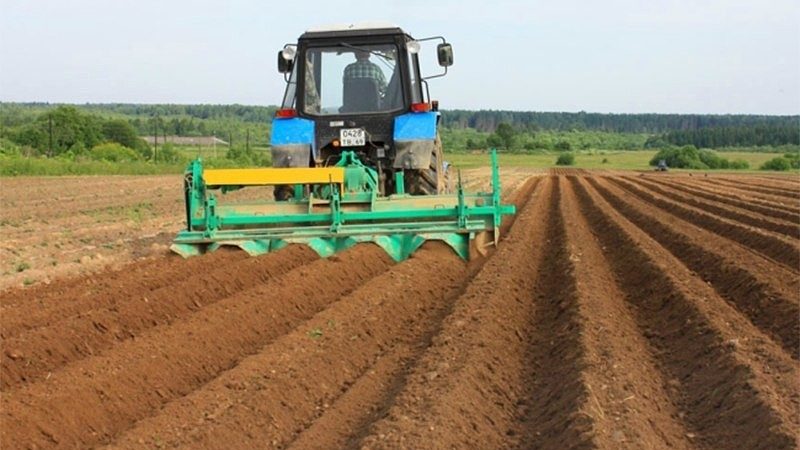
Soil preparation begins in the autumn after the harvest of the predecessor plants. Using a reversible plow, the soil is dug up to a depth of 25-36 cm, removing weeds and their roots.
Plows swap the top and bottom layers of the soil, which makes it possible to simultaneously disinfect it for pests hibernating in deep layers.Simultaneously with digging, nitrogen-containing dressings are introduced, for example, ammonium nitrate or "Nitroammofosku" in the amount of 3 kg per 1 hundred square meters of soil. Sowing of cereals, alfalfa, clover or sweet clover as siderates is allowed.
In spring, after the soil warms up to + 10 ° C, it is loosened with a cultivator to a depth of 10-15 cm. After loosening, double superphosphate (30 g per 1 m²) and potassium sulfate (30 g per 1 m²) are added.
During sowing, a thin layer - no more than 0.5 cm - of rotted manure, humus, dry chicken droppings and crushed shells is spread into the furrows. To prevent the appearance of a wireworm, dry crushed onion husks are scattered.
Landing dates
When landing in Russia, they rely on the climatic conditions of the region. The risk of night frosts must be avoided. Otherwise, the tubers will freeze.
Optimal terms - late April - early Mayhowever, in a year with a cold spring, they can move away until early June.
Landing scheme
Row spacing is of great importance in the Dutch technique. To obtain a good harvest, a width of 65-70 cm is set for early varieties of potatoes, and 75-80 cm for late varieties. This facilitates subsequent hilling, reduces the risk of cutting the developing root system.
The distance between the bushes should be 25-30 cm. Tubers are placed in holes or furrows with sprouts upwards and covered with soil 4-6 cm.
Further care
Caring for plants after planting is one of the key features of the technique. It includes regular hilling, feeding, pest control and weeding.
Top dressing
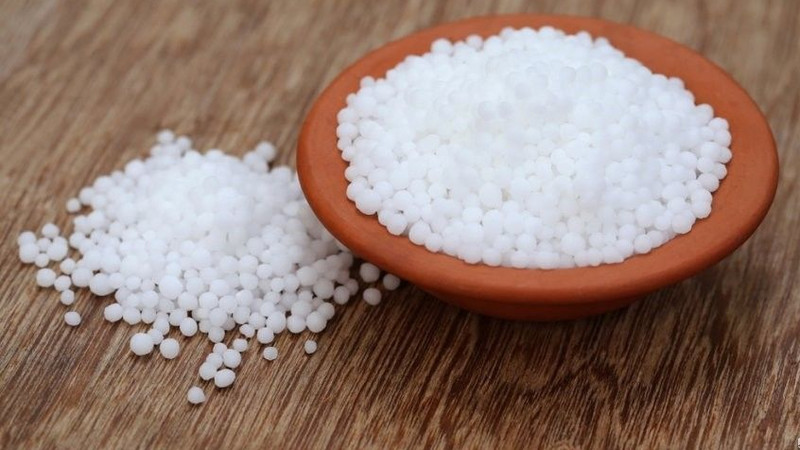
Before the first hilling, the seedlings are watered at the root of 1 tbsp. l. urea per 9 liters of warm water - 1 liter per bush. The aisles are watered with a solution of rotted cow or chicken manure.
3 weeks after the appearance of the first shoots, ammonium nitrate is additionally introduced into the beds: 20 g is diluted in 5 liters of warm water per 1 bush and carried out watering under the root. You can also add 20 g of dry matter before hilling.
Hilling
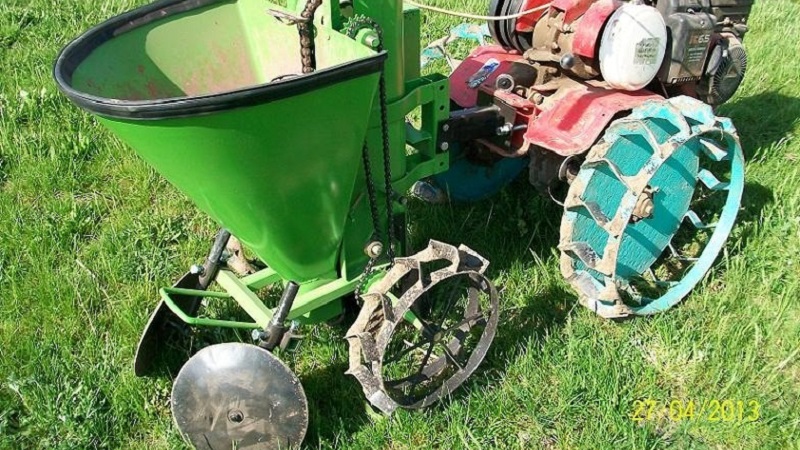
Hilling bushes carried out with a hoe, raking the soil around the plant. The result is a comb, the height of which should not exceed 25 cm, and the width at the base - 70-75 cm. In large areas for hilling use motoblocks.
The first hilling is carried out when 3-4 true leaves appear. The earth is shoveled high to the leaves (8-12 cm in height and 30-35 cm wide at the base). After 2 weeks, the procedure is repeated until a ridge of the required height is obtained.
Weed control
After sowing, high-quality herbicides are used to control weeds.
On the Russian market, good drugs are:
- Roundup. A surface treatment agent for cereal and dicotyledonous weeds. It is applied directly to the leaves and young shoots of weeds in dry, calm weather. The optimal concentration is 1-3%.
- "Centurion". The drug is of a surface action, concentrated at growth points. It is used in conjunction with "Amigo" in a ratio of 1: 3.
Watering mode
Watering is carried out no more than 3 times per season. The first watering occurs at the time of flowering, the second - 10 days after it, the third - after the end of flowering.
Protection against diseases and pests
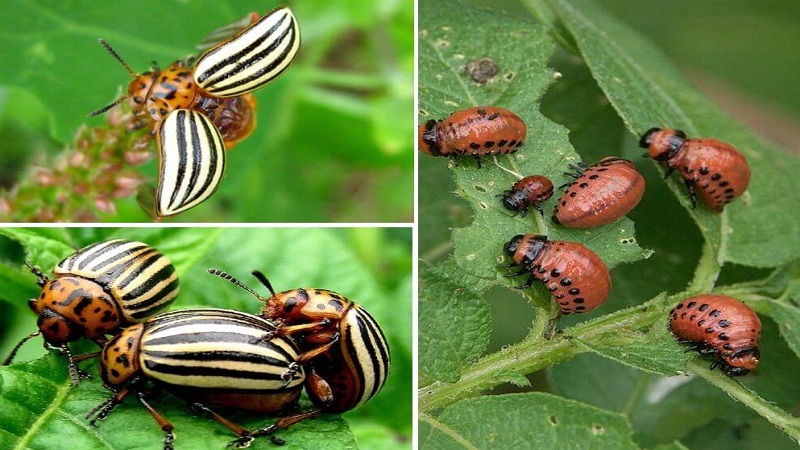
Dutch varieties are poorly resistant to late blight... Plantings are processed 5-6 times per season, observing the sequence of preparations, if possible of biological origin. The drugs "Skor", "Topaz", "HOM" are used more often.
For the prevention of viral diseases, treatment is carried out from aphids, wireworms and Colorado potato beetle ("Bankol", "Corado", "Beetle Eater"). All pest control is carried out strictly before flowering.
Difficulties in the process of growing potatoes using Dutch technology
The main difficulties in growing potatoes according to the Dutch method are the purchase of seed, the price of which is high, and adherence to the terms of agricultural technology.The latter is associated with different weather conditions, fluctuating from year to year, especially in the Urals and Siberia.
Another difficulty in the conditions of summer cottages is the need to allocate a large area and wide ridges. In this case, the adaptation of the method is allowed without the use of a complete set of all agricultural techniques.
Harvest time
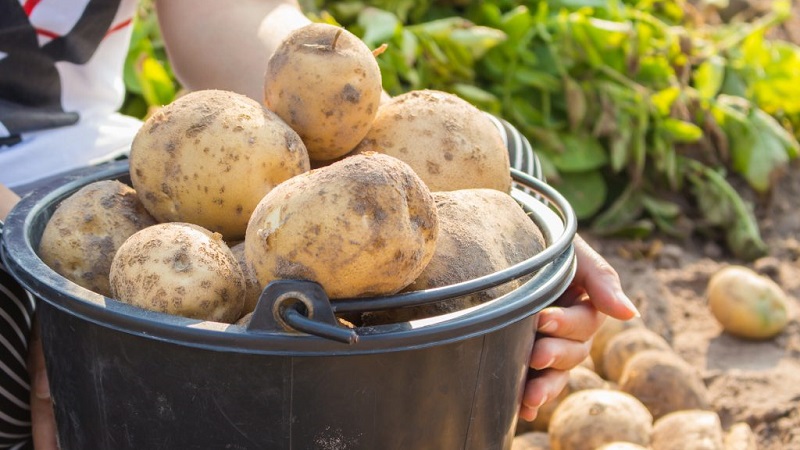
Late harvesting leads to a loss of taste and poor keeping quality of tubers. Seed potatoes are harvested in early August, food potatoes in early September. The tops are removed 10-15 days before harvest, leaving 5-7 cm from the surface of the ridge.
In small areas, the crop is harvested by hand using a pitchfork, shovel or potato digger; on farms, an elevator digger is used.
Tips and tricks from experienced gardeners
To increase yields, it is not necessary to switch to the whole complex of the Dutch technique at once. You can draw up a technological map of the list of works and timing, determine the quality of the soil, its acidity.
You can start by establishing the correct crop rotation and acquiring high-quality planting material. Then gradually switch to agrotechnical techniques inherent in the method.
Adaptation of the Dutch method to our summer cottage conditions
Adaptation comes down to processing the substrate and the use of some agricultural techniques. In small areas, manual removal of weeds without the use of chemicals is allowed.
Tubers can be planted in shallow furrows to form low ridges without further hilling.
Conclusion
The Dutch method of growing potatoes can significantly increase the yield per hectare, however, it requires strict adherence to deadlines and agricultural technology. It takes a lot of energy, time and money to buy quality seed, but these costs are reasonable. The resulting potatoes have high taste, good transportability and long shelf life.